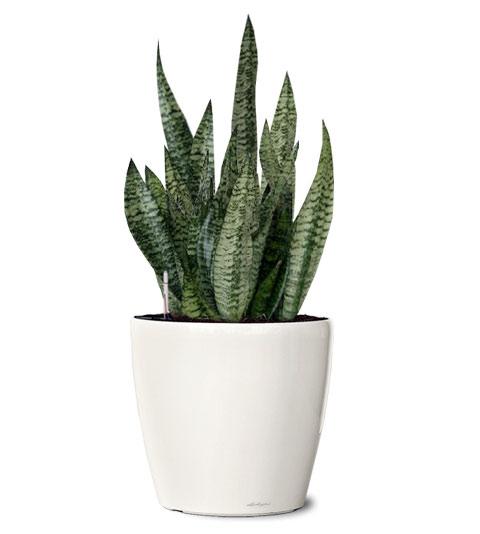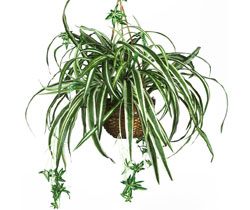Snake Plant aka Mother-in-Law’s Tongue aka Bedroom Plant
- Snake plants (Sansevieria trifasciata, laurentii) are native to West Africa and are part of the Asparagaceae family. They are known for their long, stiff leaves that are typically green or variegated with yellow or gray.
- Snake plants are known for being very easy to care for a don’t mind some neglect; they are drought-tolerant and can tolerate a wide range of light and temperature conditions.
- Snake plants are also known for their air-purifying properties. They can absorb toxins such as formaldehyde, xylene, and toluene from the air, and they release oxygen at night, making them a great choice for bedrooms.
What’s So Great About a Snake Plant?

Called Mother-in-Law’s Tongue (for its sharply pointed leaves), or Saint George’s sword, Sansevieria is especially good at clearing formaldehyde out of indoor air. [ see NASA study]. Formaldehyde is a known human carcinogen often found in the glue used in carpet backing and wood furniture, among other places.
The snake plant is a special plant that differs from most houseplants in that it produces oxygen and removes carbon dioxide at night. Keep this or a Christmas cactus in your bedroom.
Pests and Problems
This plant is easy to grow and is rarely infested with insects. The main problems you may encounter are largely under your control: don’t over-water and don’t set this plant out in the cold.
These hardy plants have few insect problems, but when it does, the most likely perpetrators are mealybugs and spider mites. The problem is that as these unwelcome pests suck sap from the leaves, they cause small wounds and leaf shedding, thus harming the plant.
Solutions: Dab a cloth in alcohol and apply to any mealybugs you see. Vanquish spider mites by washing the leaves and increasing humidity around the plant.
Great for Everybody (Except Hungry Pets)
Sansevieria are truly the easiest of plants to look after, making them a perfect choice as a first house plant for novice gardeners.
If you need to bring a housewarming gift, choose a Snake plant for the busy person or college student. This plant survives without a second look. The snake plant offers a pleasing vertical contrast when grouped with other plants in a sunroom or atrium display.
The snake plant is, however, poisonous to your pets (due to hemolytic saponin and organic acids found in the leaves and flowers) so do not let them snack on its leaves. Symptoms of ingestion include pain, vomiting, excess salivation, diarrhea, and hemolysis. Not a good time.
Care
- Semi-sun to semi-shade to shade.
- If the plant blooms, remove the flowers; they secrete a sticky substance.
- Water sparingly and let the soil dry between waterings. The snake plant might suffer root rot if over-watered. Feed a dilute liquid fertilizer once a month or whenever the rent or mortgage payment is due.
- Grow in standard potting soil in a standard container. Repot annually.
- If you opt for hydroculture, the Snake plant can go years without repotting. Pretty low-maintenance!
Snake plants have a slow to moderate growth rate and can reach up to 6-8 feet tall. They are also known for being very long-lived.
In traditional Chinese medicine, snake plant leaves are believed to have medicinal properties and are used to treat a variety of ailments such as headaches and skin conditions.
